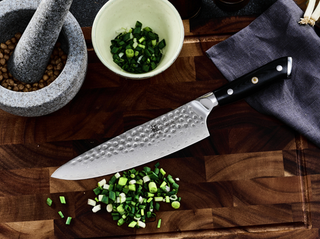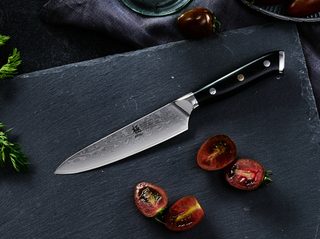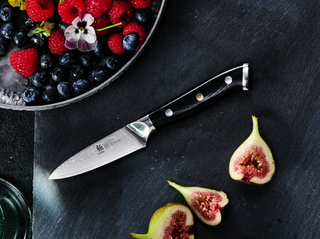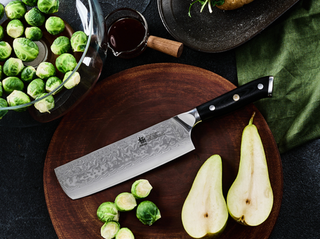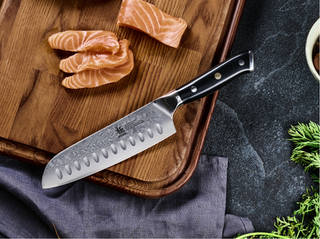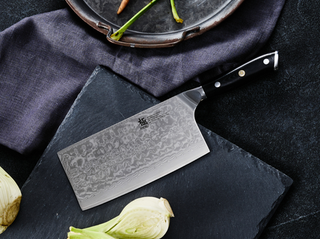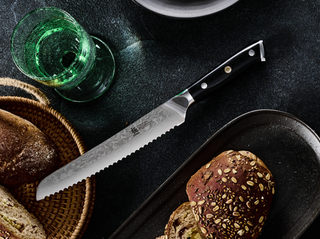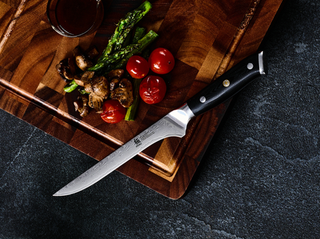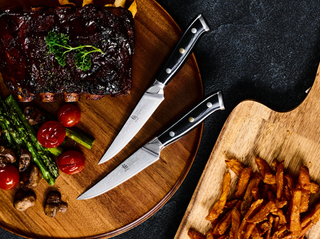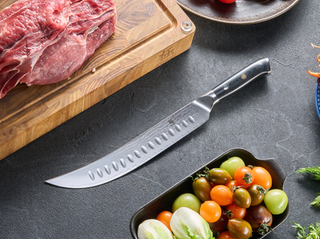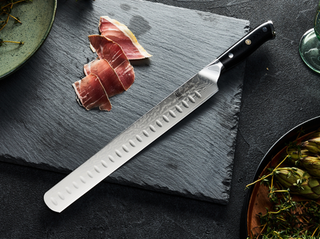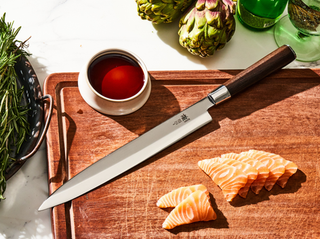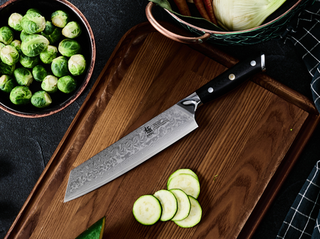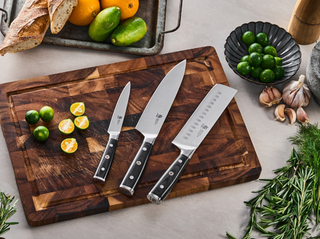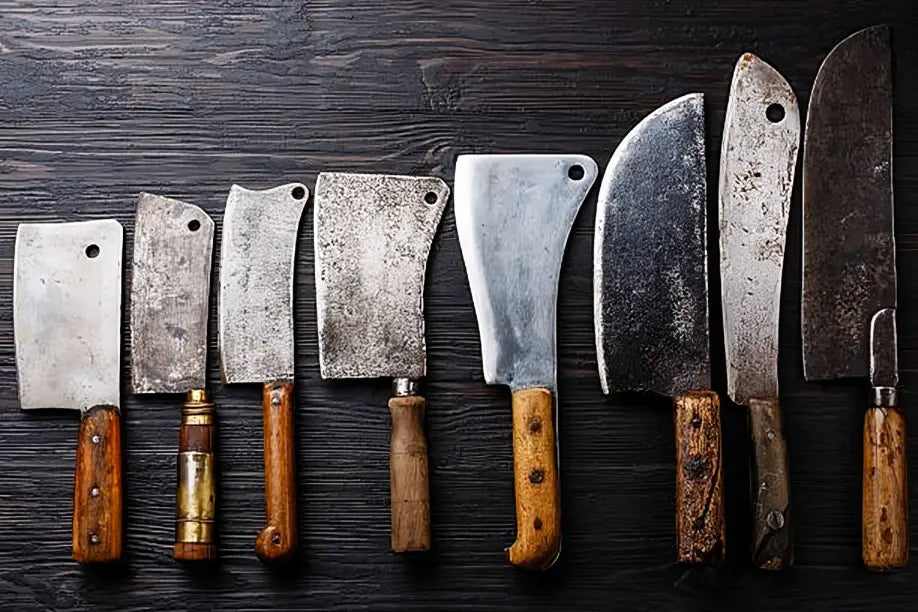Walk into any serious chef's kitchen, and you'll likely spot a cleaver knife hanging proudly on their magnetic strip. It's that distinctive rectangular blade that catches everyone's eye. But here's what most people don't realize – not all cleavers are created for smashing through bones like in the movies.
What Are the Main Types of Cleaver Knives?
Think of cleaver knives as a family of specialized tools, each with its own unique strengths. Some are built for power, others for precision, and a few can handle both. The main branches of this family tree come from Japanese, Chinese, and Western culinary traditions, each developing their cleavers to match their cooking styles.
Japanese Cleaver vs Chinese Cleaver: What's the Difference?
The contrast between Japanese and Chinese cleavers is like comparing a calligraphy pen to a paintbrush – both are masterful tools, but they serve different purposes. Japanese cleavers focus on precision and finesse, while Chinese cleavers emphasize versatility and power. This fundamental difference shapes everything from their blade thickness to their intended use.
What is a Japanese Vegetable Cleaver? (Nakiri and Usuba Explained)
The Japanese took the cleaver concept and refined it into something surprisingly delicate. Their vegetable cleavers – the Nakiri and Usuba – are more like elegant paper cutters than brute force tools. Picture slicing a cucumber so thin you can read through it. That's what these knives were born to do.
How to Choose Between Nakiri vs Usuba Cleaver

The Nakiri is your friendly gateway into Japanese cleaver territory. Its double-beveled edge means it works just like the kitchen knives you're used to, but its tall blade gives your knuckles plenty of clearance while you work. Home cooks love it because it makes quick work of prep tasks without requiring years of training.
Then there's the Usuba – the specialist's choice. It's like the samurai sword of vegetable knives, with a single-beveled edge that can split a hair lengthwise. Professional Japanese chefs use it to create those impossibly precise garnishes you see in high-end restaurants.
Chinese Meat Cleaver Guide: Understanding the Chukabocho
Chinese cleavers tell a different story. The traditional meat cleaver (Chukabocho) is what most people think of when they hear "cleaver" – thick, heavy, and ready for serious butchering work. With a blade thickness between 4mm to 8mm, it's built to handle the demanding task of breaking down large cuts of meat and bones.
What is a Caidao Cleaver? (The All-Purpose Chinese Knife)

The Caidao is where Chinese cleaver design really shines in everyday cooking.
It's not too heavy, not too light, and handles everything from mincing garlic to deboning chicken. Many Chinese home cooks use it as their only knife, which tells you something about its versatility.
Its 2-4mm blade thickness strikes the perfect balance between the delicate precision needed for vegetables and the strength required for meat preparation (though it's not meant for heavy bone work).
Western Butcher Cleaver vs Asian Cleavers: Key Differences

Western butcher's cleavers took a different path. They're the heavyweight champions of the knife world, built specifically for breaking down large cuts of meat.
You'll find them in butcher shops rather than home kitchens, and they're more about power than precision. Their thicker blades and robust construction make them ideal for heavy-duty butchering tasks.
How to Choose the Right Cleaver Knife for Your Kitchen
The best cleaver for you depends on what you cook most often. Let's break this down into practical scenarios.
For those who love making precise vegetable cuts or creating beautiful garnishes, a Japanese Nakiri offers the control and finesse you're looking for.
If you frequently prepare Asian stir-fries and lots of vegetables, a Chinese cleaver might become your go-to knife. Its versatility shines in everyday cooking tasks.
And if you regularly break down whole chickens or work with bone-in meats, a Western meat cleaver will serve you well. Just remember – you don't need to swing it like you're chopping wood.
Consider these factors when choosing your cleaver:
-
The type of food you commonly prepare
-
Your comfort level with different knife techniques
-
The maintenance you're willing to perform
-
Your budget and investment preferences
Making the Right Choice: Our Top Recommendations
Remember that moment we talked about earlier – standing in front of a challenging ingredient, wanting the right tool? Let's turn that uncertainty into confidence with these carefully selected knives.
For the Versatile Home Chef: KYOKU Damascus Steel Cleaver
Imagine the satisfaction of owning a knife that's as beautiful as it is functional. KYOKU's 7" Damascus Steel Cleaver brings this dream to life. Those mesmerizing herringbone patterns aren't just for show – they help food glide off the blade like water off a lotus leaf.
What makes this cleaver special is its sweet spot between power and precision. It handles delicate vegetable work with surprising grace, yet still tackles meatier tasks with confidence. Think of it as the Swiss Army knife of cleavers – ready for whatever your recipe throws at you.
For the Traditionalist: KYOKU Wooden Handle Cleaver
Some tools just feel right the moment you pick them up. That's the magic of KYOKU's Wooden Handle Cleaver. Its balanced weight distribution and ergonomic wooden grip make those long prep sessions feel like a meditation rather than a chore.
The full-tang construction means this knife will be telling kitchen stories for generations. It's the kind of tool that gets better with age, developing character with every meal you create.
For the Vegetable Virtuoso: KYOKU Damascus Nakiri Knife
Ever watched a master chef create paper-thin vegetable slices with seemingly effortless precision? That's the Nakiri difference. KYOKU's 7" Damascus Nakiri is like giving your vegetables the VIP treatment.
Its straight blade edge moves through produce with laser-like precision, transforming everyday ingredients into works of art. Those 67 layers of Damascus steel ensure your knife stays sharp through countless salads, stir-fries, and garnishes.
Conclusion
Whether you're breaking down ingredients for a stir-fry or preparing vegetables with professional precision, the right cleaver can transform your cooking experience. Like any skilled craftsperson, a cook is only as good as their tools.
Take time to master your chosen blade. Learn its rhythms, respect its strengths. Soon enough, you'll wonder how your kitchen ever felt complete without it.
